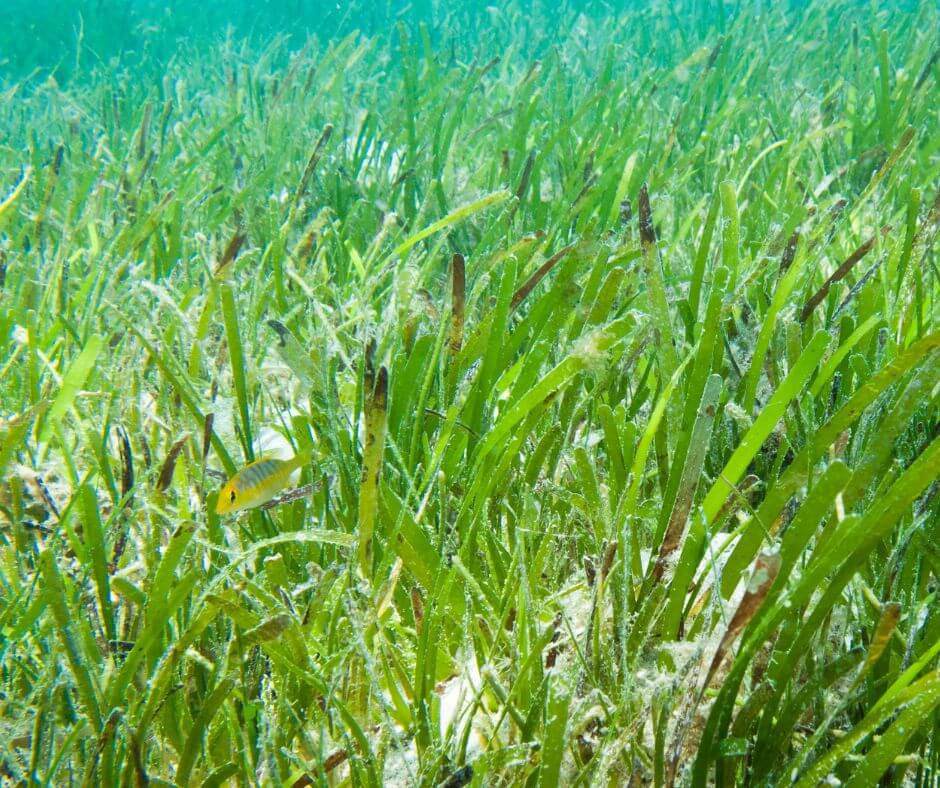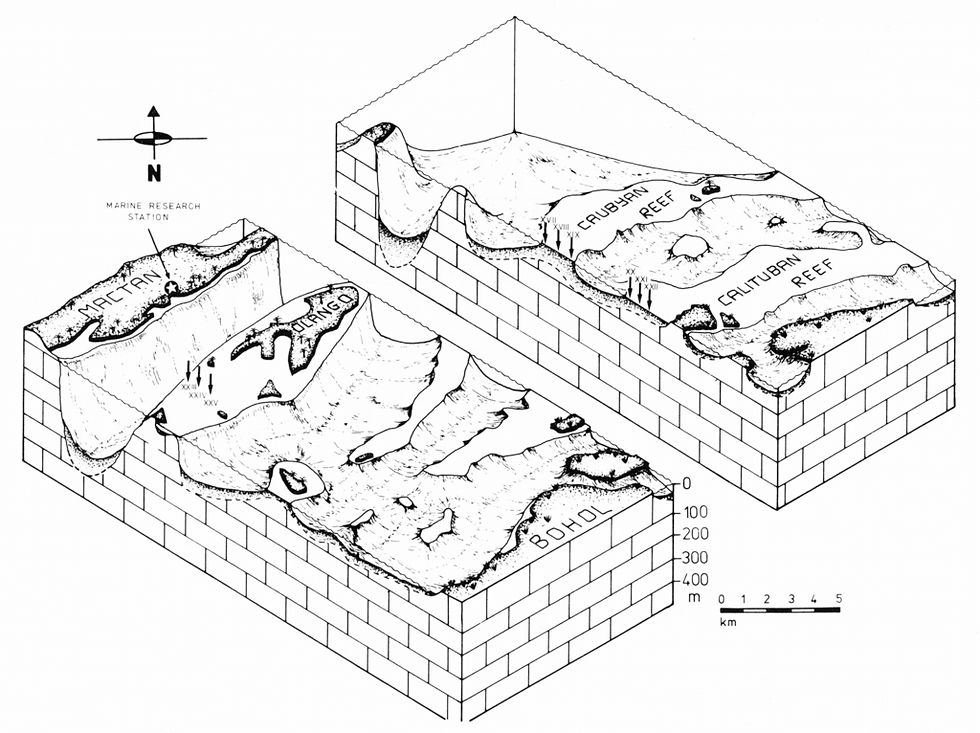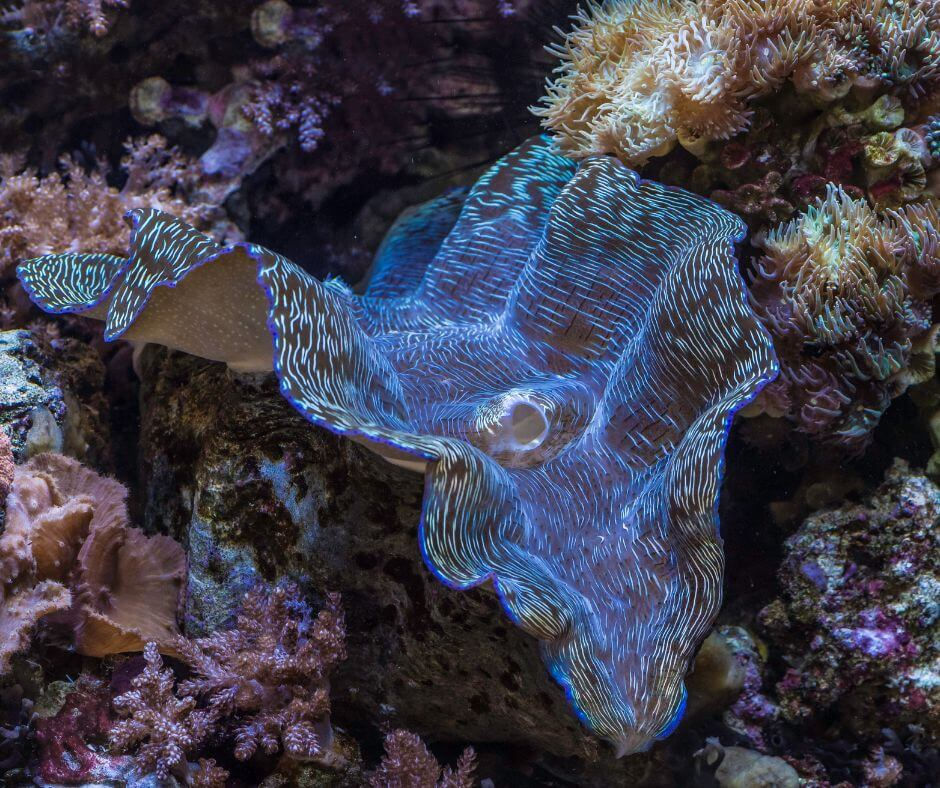Danajon Bank
- KGM Resorts
- Aug 22
- 10 min read
The Philippines’ Hidden Double Barrier Reef

Nestled in the heart of the Visayas, between the islands of Bohol, Cebu, and Leyte, lies one of the Philippines' most extraordinary marine treasures: Danajon Bank. Spanning over 156 kilometers, this stunning reef system is not only a spectacle of natural beauty but also a globally significant ecological marvel.
What sets Danajon Bank apart from other reef systems in the country is its geological rarity—it is one of only six double barrier reefs in the world, and the only one in the Philippines. Formed through a unique combination of tectonic movements and coral growth over thousands of years, this underwater formation comprises two parallel reef systems, a feature so uncommon it draws interest from marine biologists and conservationists worldwide.
But Danajon Bank is more than just a scientific curiosity. It serves as a critical habitat for marine biodiversity, supporting a complex ecosystem of coral gardens, seagrass beds, mangroves, and over 200 species of fish. It plays a vital role in the lives of local coastal communities, providing food, income, and cultural identity for generations of fisherfolk and their families.
As both a natural barrier against storm surges and a biological haven, Danajon Bank stands as a living testament to the Philippines’ rich marine heritage—and a powerful reminder of what is at stake if such wonders are not protected.
Geological Significance
A Rare Geological Phenomenon
Double barrier reefs are extremely rare, with only six confirmed formations around the globe. Unlike typical fringing or single barrier reefs, a double barrier reef consists of two parallel coral reef systems separated by a lagoon or channel. This intricate structure creates a layered marine environment that supports more complex biodiversity and natural defenses.
Birth of Danajon Bank
Danajon Bank was formed through a convergence of tectonic uplift and coral reef accretion over thousands of years. Situated along the tectonically active region of the Philippine archipelago, the seabed rose gradually, providing the ideal conditions for coral growth. Over time, corals accumulated on submerged ridges, forming two distinct reef lines parallel to the coastlines of Bohol, Cebu, and Leyte. This evolution was shaped by natural processes such as sedimentation, volcanic activity, and fluctuating sea levels.
Comparison to Other Global Reefs
While other double barrier reefs exist in places like Belize, New Caledonia, and parts of Australia, Danajon Bank stands out as the only known example in Southeast Asia. Its unique position within the Coral Triangle—a marine region recognized as the global center of biodiversity—further elevates its scientific and ecological importance.
A Natural Shield and Ecological Engine
Geologically, Danajon Bank plays a critical role as a natural coastal defense system. Its reef walls buffer the effects of tropical storms and typhoons, reducing the force of storm surges that threaten coastal towns. Additionally, the reef’s structure nurtures high marine productivity, supporting spawning grounds and nurseries for fish, crustaceans, and invertebrates that sustain local fisheries.

Rich Biodiversity and Marine Life
Coral Gardens and Seagrass Meadows
Danajon Bank boasts a spectacular mosaic of marine ecosystems, including fringing reefs, barrier reefs, patch reefs, and extensive seagrass beds. These varied coral structures create a diverse habitat that supports a wide range of marine organisms. The lush seagrass meadows act as feeding grounds for sea turtles, dugongs, and various juvenile fish species, while the corals provide shelter and breeding grounds for countless marine creatures.
A Sanctuary for Endemic and Endangered Species
This rare reef system is home to over 200 species of fish, as well as a multitude of mollusks, crustaceans, echinoderms, and marine reptiles. Among its most remarkable residents are endangered sea turtles, giant clams (Tridacna spp.), seahorses, and the critically endangered Napoleon wrasse. The reef also supports Philippine-specific species such as the Philippine pufferfish and several types of endemic coral and reef fish.
Nature’s Nursery
Danajon Bank functions as a vital nursery ground where fish and marine invertebrates spawn and grow before migrating to deeper waters. Species such as groupers, snappers, parrotfish, and squid depend on the reef’s calm lagoons and rich plankton blooms during their juvenile stages. This ecological role is crucial not just for species survival, but also for replenishing surrounding marine environments.
Lifeline for Local Fisheries
Thousands of coastal residents from Bohol, Cebu, and Leyte depend on Danajon Bank for their livelihood. The reef supports artisanal and small-scale fisheries, providing food and income for communities through sustainable harvesting of fish, sea cucumbers, and shellfish. It is considered one of the most productive reef fisheries in the country and plays a central role in the food security and economic resilience of the Visayan region.
Communities and Cultural Connection
Coastal Communities That Depend on the Reef
Danajon Bank stretches across the coasts of Bohol, Cebu, and Leyte, touching over a dozen municipalities including Bien Unido, Getafe, Talibon, and Ubay in Bohol; Camotes Islands in Cebu; and Carlos P. Garcia, among others. These areas have long depended on the reef’s resources for both subsistence and commerce. It is not just a reef—but a lifeline woven into the fabric of coastal living in Central Visayas.
Traditional Fishing Knowledge and Practices
For generations, local fisherfolk have developed intimate knowledge of Danajon’s tides, coral patches, and migratory fish patterns. Techniques like hook-and-line, fish corrals (baklad), and gleaning have been refined and passed down, reflecting a deeply ingrained understanding of sustainable fishing. Community-managed marine protected areas (MPAs) and locally enforced fishing seasons are becoming more common, helping to restore fish populations and coral health.
Life Along the Reef’s Edge
In these reef-dependent towns, daily life often begins before sunrise. Families go out in small bangkas (outrigger canoes), casting nets or free-diving for fish, sea cucumbers, or shellfish. Children help mend nets while elders sort the day’s catch. The rhythm of life beats to the pulse of the tides, and community bonds are strengthened by a shared connection to the sea.
From Sea to Market: The Local Seafood Economy
Danajon Bank supports a thriving seafood industry—from fresh fish sold at roadside markets to dried squid, seaweed farming, and sea cucumber trading, which is an important export product. These coastal economies rely not only on fishing but on processing, transport, and local market trade, with women often playing key roles in post-harvest handling and seafood commerce.

Conservation Challenges
Despite its ecological importance and global rarity, Danajon Bank faces mounting environmental threats that jeopardize its future.
Overfishing and Illegal Practices
Centuries of fishing have intensified, and in recent decades, unsustainable and destructive practices like dynamite fishing, cyanide fishing, and muro-ami have devastated coral cover and fish populations. Overfishing has led to depleted stocks, reducing the reef’s ability to regenerate and continue supporting local communities.
Climate Change and Coral Bleaching
As ocean temperatures rise, coral bleaching events have increased in frequency and severity. Corals lose their vibrant colors and ability to support marine life when stressed by heat. Combined with ocean acidification, these effects weaken the very foundation of the reef ecosystem.
Coastal Development and Sedimentation
Expanding coastal infrastructure, such as ports, resorts, and fish farms, contributes to soil erosion and sediment runoff. This murky water smothers corals, blocks sunlight, and disrupts photosynthesis. Moreover, unregulated land reclamation and mangrove destruction worsen the reef’s vulnerability.
Weak Enforcement and Fragmented Governance
Though marine protected areas (MPAs) exist along portions of Danajon Bank, lack of consistent enforcement, limited funding, and fragmented jurisdiction between municipalities weaken their effectiveness. Illegal fishing often goes unchecked, and community-based initiatives lack the broader government support needed to succeed at scale.
Current Conservation Efforts
Despite the threats it faces, Danajon Bank has become a focal point for multi-sector conservation efforts aimed at protecting this rare marine ecosystem.
Marine Protected Areas (MPAs) and Community-Managed Zones
Over the years, MPAs have been established across key sections of Danajon Bank, providing legal protection for fish breeding grounds and coral recovery zones. Many of these MPAs are co-managed by local communities, where fisherfolk have taken the lead in guarding their own marine backyard through no-take zones and seasonal fishing bans.
NGO, Government, and Local Partnerships
Organizations such as Rare Philippines, SeaLifeBase, and various academic institutions have partnered with BFAR (Bureau of Fisheries and Aquatic Resources), DENR (Department of Environment and Natural Resources), and local LGUs (Local Government Units) to drive coordinated conservation programs. These alliances provide vital funding, training, and technical expertise.
Monitoring, Patrols, and Reef Restoration
Grassroots initiatives include reef monitoring programs, Bantay Dagat (sea patrol) volunteer groups, and coral replanting projects to rehabilitate damaged sections of the reef. These patrols help enforce fishing regulations and prevent illegal activities, while restoration efforts aim to revive reef health and fish populations.
Environmental Education and Youth Engagement
Education programs run in coastal barangays and schools raise awareness of Danajon Bank’s ecological value. Youth groups participate in coastal clean-ups, mangrove planting, and citizen science projects, nurturing a new generation of marine stewards.

How to Visit and Support Responsibly
While Danajon Bank is a fragile ecosystem, it also offers immersive opportunities for travelers to engage with the marine environment in ethical and sustainable ways. Here’s how you can experience its magic while helping protect it.
Dive and Snorkel in Key Entry Points
Some of the best jump-off towns for marine exploration include:
Bien Unido, Bohol – Known for its Underwater Grotto and proximity to vibrant reef patches ideal for both snorkelers and divers.
Talibon and Getafe, Bohol – Access points to various Marine Protected Areas and community-run dive sites.
Ormoc and Palompon, Leyte – Offer boat tours and limited diving in the outer reaches of the reef system.
Be sure to book with licensed local dive operators who practice low-impact diving protocols.
Responsible Marine Tourism Tips
Do not touch or step on corals – even the lightest touch can damage them.
Use reef-safe sunscreen to avoid introducing harmful chemicals into the water.
Avoid collecting marine life as souvenirs.
Respect no-fishing and no-anchor zones designated by local MPAs.
Travel in small groups and use outrigger boats that minimize seabed disruption.
Contribute to Reef Protection
Participate in eco-volunteer programs, such as coral planting or reef monitoring (some NGOs offer day-long or week-long experiences).
Join coastal cleanups if your visit aligns with community activities.
Donate to conservation groups actively working in Danajon Bank.
Share your experience ethically, raising awareness about responsible reef tourism through blogs or social media.
By choosing eco-friendly travel and supporting grassroots efforts, your visit becomes a powerful contribution to the preservation of one of the planet’s rarest reef systems.
Future Outlook – Protecting a Natural Legacy
Danajon Bank stands not only as a marine treasure of the Philippines but also as a global rarity that demands continued vigilance and care. Preserving this double barrier reef system for future generations requires unified action, policy backing, and community-driven stewardship.
Sustained Conservation Funding and Policy Support
To maintain long-term protection, consistent funding is essential for reef monitoring, community programs, and scientific research. National and local government policies must prioritize marine biodiversity, allocating resources for ranger patrols, coral restoration, and marine science education.
Stronger policy alignment is also needed between agencies like DENR, BFAR, and local government units to streamline and scale reef conservation.
Expanding Marine Protection and Enforcement
Currently, only small portions of Danajon Bank are under formal protection. Advocates call for the designation of larger Marine Protected Areas (MPAs) that encompass the reef’s full span. Coupled with stricter enforcement of anti-illegal fishing laws and penalties for environmental violations, these protections are vital in reversing reef degradation.
Technology like satellite tracking, community surveillance, and transparency in fishing practices will be key in these efforts.
Eco-Tourism as a Sustainable Path
Responsible eco-tourism offers hope as a low-impact, high-value model for both conservation and livelihood. With its rare reef system, Danajon Bank can attract divers, marine biologists, and nature travelers seeking ethical adventure.
By training local guides, establishing reef-safe infrastructure, and controlling visitor impact, tourism can fuel both environmental protection and economic growth in coastal communities.
Call to Global Awareness and Action
Danajon Bank may be located in the heart of the Philippines, but its importance is planetary. As one of only six double barrier reefs on Earth, it plays a role in climate resilience, food security, and marine science. Travelers, scientists, and citizens from around the world can amplify its story by:
Supporting local NGOs and conservation projects
Promoting awareness through social media and education
Lobbying for stronger marine protection policies
Choosing sustainable seafood and reef-safe products
The future of Danajon Bank depends not just on those who live near it—but on all of us who care for the oceans.

Frequently Asked Questions (FAQ)
Where exactly is Danajon Bank located?
Danajon Bank lies in the central Philippines, between the islands of Bohol, Cebu, and Leyte in the Central Visayas region. It stretches across the Camotes Sea and is bordered by several municipalities, including Bien Unido (Bohol), Talibon, and the northern parts of Cebu and Leyte.
Can tourists dive or snorkel there?
Yes, but access is limited to certain areas. While Danajon Bank is not yet a mainstream tourist destination, dive shops in Bien Unido (Bohol) and other nearby towns offer snorkeling and scuba diving tours to parts of the reef. These experiences focus on coral gardens, fish nurseries, and sometimes include underwater attractions like religious statues.
Is it protected by law?
Parts of Danajon Bank are protected under local Marine Protected Areas (MPAs) and environmental ordinances, but there is no single unified national-level protection covering the entire reef system. Conservation advocates continue to push for broader and stricter legal protection given its ecological significance.
How can I help protect the reef?
You can support Danajon Bank’s protection by:
Choosing responsible dive operators and reef-friendly activities
Donating to local NGOs like Rare Philippines or SeaKnights that work on reef conservation
Raising awareness about this rare reef system through education and social media
Avoiding reef-damaging products, such as chemical sunscreens or non-sustainable seafood
Supporting community-based ecotourism initiatives in Bohol, Cebu, and Leyte
Takeaway – A Reef Like No Other
Danajon Bank is not just a marvel of marine geology—it is a living, breathing ecosystem that sustains thousands of species and countless coastal communities in the Philippines. As one of only six double barrier reefs in the world, it holds both global scientific value and deep cultural resonance for Filipinos who rely on its bounty.
But this rare underwater treasure faces mounting threats—from climate change and illegal fishing to weak enforcement and development pressures. Despite these challenges, hope remains strong. Through community stewardship, marine protected areas, and growing ecotourism initiatives, Danajon Bank stands as a symbol of what’s possible when people and nature work together.
Visiting or supporting this fragile ecosystem is more than an adventure—it’s a chance to be part of something bigger: the effort to preserve one of Earth’s rarest natural wonders. Let Danajon Bank inspire you to explore responsibly, give back, and help protect the ocean’s future—starting with the Philippines’ double reef jewel.
















"Let Danajon Bank inspire you to explore responsibly, give back, and help protect the ocean’s future—starting with the Philippines’ double reef jewel" - Kubo
Just wow 😲
Geologically, Danajon Bank plays a critical role as a natural coastal defense system. Its reef walls buffer the effects of tropical storms and typhoons, reducing the force of storm surges that threaten coastal towns.
Danajon Bank a kind of underwater that has double barrier reefs. It is a rare ecosystem and it is a marine protected area.
Nestled in the heart of the Visayas, between the islands of Bohol, Cebu, and Leyte, lies one of the Philippines' most extraordinary marine treasures: Danajon Bank. Spanning over 156 kilometers, this stunning reef system is not only a spectacle of natural beauty but also a globally significant ecological marvel.